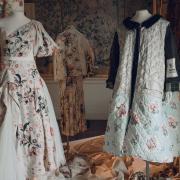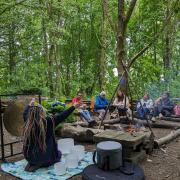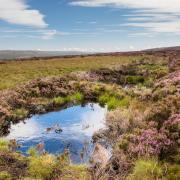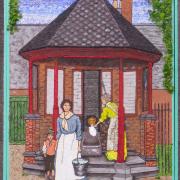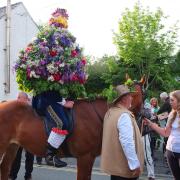‘I feel privileged in my career to have travelled the world, yet the offer and reach of Chatsworth is quite incredible’ says Chatsworth House Trust’s director Jane Marriott as she reflects on a year in the role.
Having relocated from London ten years ago, Jane became MD and trustee at Hepworth Wakefield following a six-year tenure as director at Harewood House Trust, before securing an exciting role at Derbyshire’s most famous estate.
She brings with her invaluable experience across the arts; from her History of Art degree to curatorial, marketing, fundraising and editorial roles at prestigious London galleries, institutions and museums - including The Royal Academy of Arts, The National Gallery, The Tate and The British Museum.
Jane oversees the safeguarding of the Trust’s renowned Devonshire Art collections and its archives. She also leads an ambitious creative programme designed to broaden audiences, whilst ensuring the charity’s social impact is far reaching.
‘Country houses in the past may have been concerned with status and entertainment, but now these are places which allow us to reconnect with nature and step out of the pressures of daily life,’ explains Jane.
‘We not only have a role in telling the story of the house and its collections, we play a vital role in making a difference within the community.’
Here, we discover how Chatsworth plans to inspire current and future generations, whilst raising awareness of the key issues of our time.

Since your appointment, what challenges have you encountered?
One key challenge has been raising awareness of Chatsworth as a charity. We've discovered from our research that many believe Chatsworth is privately owned and that profits are for a company or family, which isn’t the case.
Every penny a visitor spends on an entrance ticket goes back into the charity. This allows us to maintain the house, grounds and parkland and invest in learning programmes, community projects, conservation and exhibitions.
I want to thank everyone who comes through the doors, it keeps Chatsworth going.
Which projects have been the most rewarding to be involved with?
I really enjoyed being part of Chatsworth at Christmas and seeing the creative ideas envisaged throughout the house and gardens by our team.
Whether our themes link to the collections, the family’s history, or the interiors in the house, it’s not something that could be hosted anywhere else in the country.
It’s also wonderful to see visitors return every year - we shouldn’t underestimate how important Chatsworth is in making memories.
For many at Christmas, Chatsworth isn’t just a social visit, it’s valuable time with loved ones and friends or an opportunity to reconnect with nature.
I believe this is one of the reasons we have such a loyal base and why there is so much pride in the area for Chatsworth as well.
How do you plan to broaden Chatsworth’s reach?
We understand the cost can be prohibitive for some, so this year our offer will be revised for those on universal or pension credit, and for families.
Our pricing will include a new children’s ticket which means that anywhere within the grounds or house, a child’s ticket will not cost more than £10. In addition, there will be a peak and off-peak ticket, so you can choose days or times which are more affordable.
We’re also considering how we create quiet times for those who find it difficult within busy spaces, whilst ensuring our site is accessible as a physical space for visitors with additional needs.
Ultimately, we want Chatsworth to be accessible, welcoming and a place for everyone - this is really important to us.
What are the plans for the restoration of the Cascade?
This is a particularly exciting project which we are looking forward to developing having secured funding from The National Lottery Heritage Fund to kick-start the project.
We value the Cascade as an incredible historic water feature which enables us to share stories, as our visitors engage in it in very different ways.
There are families who splash in the water during summer, those interested in its design and engineering, whilst there’s an important story around how precious it is as a commodity, particularly in relation to the growing climate crisis.
We hope to showcase the sustainable functionality of the Cascade in being completely powered by water, collected from rainfall which is then connected to the fountain and pond, which then returns to the River Derwent and the process starts again – this was and still is very innovative for its time.
Recent exhibitions have included exciting collaborations with international artists, will this continue?
We are proud of Chatsworth being a home of creativity, focused on supporting new artists and talented makers.
This mindset continues a tradition of a family who have commissioned incredible artists, designers and makers over 500 years, many of whom would have been contemporary for their time.
These exhibitions also demonstrate Chatsworth is not only an important Derbyshire and UK asset, but is recognised worldwide.
I’m passionate that our audiences don’t need to travel to see world class art, because we can rival anything offered in the capital or elsewhere.
How do you hope to inspire visitors and make a positive impact through new exhibitions?
It’s important to give artists a platform to raise current issues through their work.
Artists within our Mirror Mirror exhibition highlighted themes around the climate and told very serious and important stories in an entertaining and engaging way. We feel engaging in an emotional way which generates interest and empathy of the issues raised can lead to change; this is a big part of our responsibility in having a large audience.
Mirror Mirror was not only a fantastic exhibition, it potentially inspired 600,000 people – if everyone who visited initiated one small change, imagine the impact.
How will the organisation continue to grow as a valuable educational resource?
This is at the heart of everything we do. Every year we invest in our priorities, with learning and conservation at the top of our agenda.
We have made a commitment for every school in the region to benefit from Chatsworth through its collections and the environment. This is planned in a number of ways, from formal tours to workshops in our outdoor learning centre.
We also understand lots of schools cannot afford to travel, so we’ve set up a transport fund to offer support for transportation costs.
As many schools may not have time or resources to bring children to Chatsworth, we offer virtual tours and as part of our outreach programme our teams go to schools and take interesting objects with them.
With such vast archives, how does Chatsworth intend on showcasing these to maximum affect?
We continue to research our collections and add as much as possible online, where you can access everything from our picture library, stories about our collections, through to our servants’ database. Many are really interested in the latter as they wish to research their family’s history.
To highlight our collections to a wider audience, we also loan pieces to museums and galleries around the world.
On site, the collections and stories around them are important, so we’re planning a ‘spotlight’ exhibition this year where we look at just one piece and tell that story.
We will also have ‘conservation in action’ where the textiles conservation team showcase their work, which generally happens behind the scenes, and will answer questions whilst visitors tour the house.

Are Chatsworth’s archives and collections accessible for designers and academic research?
We have a study room where academics and researchers make appointments for accessing our archives and this year we will appoint a new position of ‘Chatsworth Fellowship’ where we will invite an expert in their field to research a particular part of the collection; this will lead to an exhibition or a publication and we plan to rotate the Fellowship every few years.
To illustrate how our collections continue to be a source for inspiration, we will showcase an exciting fashion exhibition where visitors will see how Chatsworth’s beautiful jewellery and textiles pieces have inspired a contemporary fashion collection of one of the world’s leading designers.
What do you see as the key issues of our time that Chatsworth can help address?
For me the three most pressing and urgent issues are the climate crisis, health and wellbeing and equality, diversity and inclusion.
At Chatsworth, we are planning to be as inclusive as possible by making sure it’s a place for everybody, that our teams are well informed, trained and supported and our programme appeals to different audiences.
As well as highlighting climate change issues within exhibitions, we hope to incorporate onsite electric transport and will continue to encourage visitors to travel to us by bus by offering a free guidebook as a thank you.
We’re looking at how we can use and recycle waste, whilst ensuring we use sustainable gardening practices which encourage biodiversity around the estate and parkland.
Health and wellbeing initiatives are a really focus and we want to encourage visitors to explore our outdoor spaces through our programme of walks and nature related activities.
What social, artistic and environmental legacy do you hope Chatsworth will leave for future generations of visitors?
Chatsworth is a place for creativity and community. We want to enrich lives and make a difference to those who engage with us - whether online around the world, on our learning programmes, through exhibitions, or from communities on our doorstep.
If we can be relevant, inspire, and welcome the world whilst addressing important issues, I will feel we’ve made a real difference.










